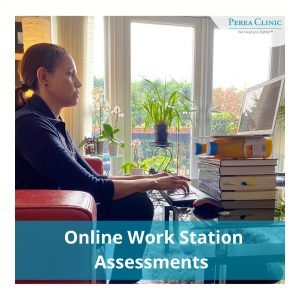Home Workstation Set-up help for you online
The benefits of DSE assessments might not be something that gets your heart beating faster, but it can make your back and neck less achy! With so many people currently working from home at rather awkward “workstations” (to use the term loosely), this has suddenly become a huge issue. The BBC is regularly reporting on the long-term problems likely to arise if we don’t sit properly, using the best possible screen, chair and keyboard positioning. If you would like a 15 minute assessment of your at-home working set-up (done remotely online), please call us or just book yourself in here. We have lots of easy “hacks” that can help you adjust to a safer and more comfortable working environment.
Continue reading below if you would like to learn more about the importance of the right positioning for your chair, screen, keyboard, feet, mouse (etc.), and how your working set-up can cause long-term back, neck, shoulder, eyesight and repetitive strain injuries if left unchecked.
As Aristotle said, ‘you are what you repeatedly do’. Or in this case, your body reflects how you use it most often. Compromising your posture for long periods of time can cause a lot of problems.
What is DSE?
DSE, short for Display Screen Equipment, relates to all the types of equipment you use regularly in an “office” environment. Health and Safety regulations were introduced in 1992 to put the onus on employers to ensure their employees are safeguarded.
What are the benefits?
The regulations advise you to set your workstation correctly to prevent back, neck pain and other MSK disorders. Take regular, short breaks, with 5 minutes off in every 30 considered “optimum”. A short break that incorporates movement will keep blood flowing and is good for your cardiovascular health. It is also good for your “cerebrovascular” health, in other words, you mind will function and concentrate better.
DSE assessment helps you decrease screen glare and use correct text size, thereby reducing the likelihood of headaches and migraines.
Getting rid of lazy habits
Making just a few adjustments can make a big difference to how you feel on a daily basis. You should check and recheck your posture and workstation on a regular basis, to prevent bad habits creeping back. Create “prompts” to remind yourself, such as alarms for taking a break, and pictures to remind you of the best seating position. As you start to form a new at-home habits, your body will thank you for it. And you should feel a lot fresher at the end of the day.
The harmful effects of poor posture at work
Don’t wait until it is too late. Please take proper measures to ensure you are sitting in the correct position in your chair, even if at home. The aim is to avoid conditions that are associated wit poor working posture, such as:
- Tight lower backache or neck ache
- Repetitive strain injuries (RSI)
- Work related injuries such as disc damage
- Headaches and migraines
- Fatigue, and problems sleeping
- Joint pain (with greater likelihood of arthritis long term)
- Digestive problems
- Tightness of the chest, and breathing issues
- Elevated levels of stress
What is the correct sitting position?
Sitting correctly minimises the stress and strain on muscles and joints and allows good circulation. A relaxed posture helps you to breathe normally. The first step is to be more aware of how you are sitting. Getting someone to take pictures or video for you can be totally enlightening! Then there are certain things you can do to improve your posture:
- Aim to keep your feet flat on the floor
- Have your chair at a height that allows your thighs to be parallel to the floor
- Your arms should rest flat with wrists straight (not cocked at an angle)
- Ensure the top of your screen is at eye-level to keep your head in a balanced position
- Make sure the base of your spine is properly supported.
Call us or click here to discuss any issues you have, or to book an online assessment. If you are already suffering, we also do online physio, osteopathy or Sports Therapy consultations too!
We hope this information is useful. If you need advice or have any questions about our treatments, please contact us. You can find us in Mill Hill Broadway and Islington. We are glad to help.
If you like this blog, please share it!






Thanks for the great tips. I ve readjusted my position and will see how I go in the next few days. Can’t wait for the clinic to open again. Will come and see one of the osteopaths. I ve picked up a back injury already, with all the sitting around and running outside. Keep up the good work.
I’m glad you enjoyed our blog!
We will be posting some stretches on Instagram (@pereaclinic) soon for anyone looking tips until we are able to open.